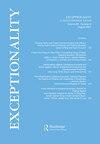Person-centered Transition Planning for Youth on the Autism Spectrum: What are We Still Missing?
IF 0.9
4区 教育学
Q4 EDUCATION, SPECIAL
引用次数: 6
Abstract
ABSTRACT The person-centered individualized education program (IEP) transition planning has emerged as a primary indicator of quality services, and as a predictor for successful post-school outcomes for transition-age youth with autism spectrum disorders (ASD). However, these person-centered transition practices are not uniformly implemented across the United States. Using a combined Self-Determination Theory and Ecological Systems Theory, we examined the facilitators and barriers of implementing the person-centered transition practices for youth with ASD. We conducted interviews with 21 stakeholders including youth with ASD, parents, and professionals. The current findings indicated that person-centered transition planning practices for youth with ASD showed inconsistencies and areas of need for improvement. Four key factor levels were identified based on a theoretical framework: individual level, microsystem, mesosystem, and exosystem. There were multifaceted and dynamic transactional relationships across multiple individual- and systemic-factors with respect to the person-centered IEP transition planning.自闭症谱系青少年以人为本的过渡规划:我们还缺少什么?
摘要:以人为中心的个性化教育计划(IEP)过渡规划已成为衡量服务质量的主要指标,也是自闭症谱系障碍(ASD)过渡年龄青年放学后成功的预测指标。然而,这些以人为中心的过渡做法并没有在美国统一实施。采用自决理论和生态系统理论相结合的方法,我们研究了ASD青年实施以人为中心的过渡实践的促进因素和障碍。我们采访了21位利益相关者,包括自闭症谱系障碍青年、家长和专业人士。目前的研究结果表明,自闭症谱系障碍青年以人为中心的过渡规划实践显示出不一致性和需要改进的地方。基于理论框架确定了四个关键因素水平:个体水平、微系统、中系统和外系统。在以人为中心的IEP过渡规划方面,存在多个个人和系统因素之间的多方面和动态的交易关系。
本文章由计算机程序翻译,如有差异,请以英文原文为准。
求助全文
约1分钟内获得全文
求助全文

 求助内容:
求助内容: 应助结果提醒方式:
应助结果提醒方式:


